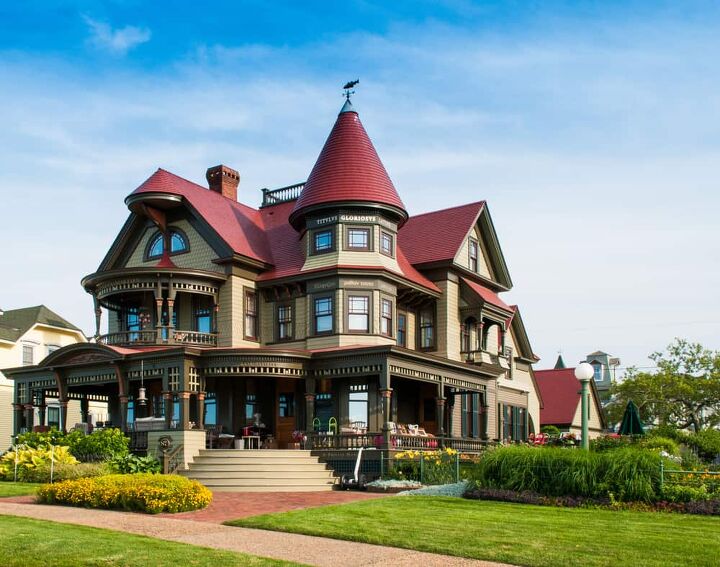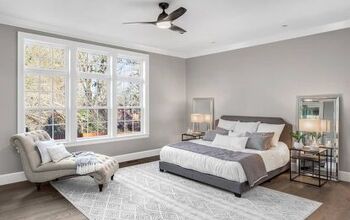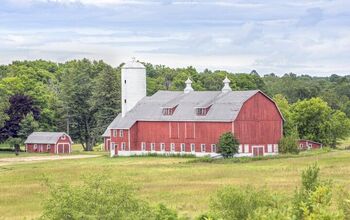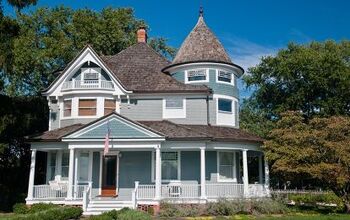Victorian House Floor Plans (with Drawings)

Victorian architecture emerged between 1830 to 1910 when Queen Victoria reigned. The Victorians built this style of house to reflect the world around them. The Industrial Revolution nationalized the Victoria trend by incorporating advanced technology in Victorian-style homes.
A Victorian house refers to the era of the home’s construction rather than the style. Various factors characterize Victorian houses, including height, decoration, mixed materials, and assorted colors.
What Is a Victorian House?
Victorian houses are the product of the period in which people built them. This house style was named after Queen Victoria during 1830 to 1910 and was inspired by the Industrial Revolution.
During this time, there was an advance in manufacturing and transportation. Because of this, it allowed builders to have access to better quality materials. This led to more complex and decorative designs as well as applying colored paint to buildings for the first time.
Victorian House Styles
Over the century, Victorian houses continued to be popular and spread across the colonies. The architecture evolved, creating three different distinct Victorian styles. These Victorian styles are Gothic Revival, Folk Victorian, and Queen Anne.
Gothic Revival Style Home
Medieval architecture and the Romantic art movement influenced the Victorian home. . You’ll find this style in cathedrals, castles, and university buildings. People refer to a sub-type of this style in rural areas as Carpenter Gothic.
Gothic Revival Victorian homes are characterized by their pointed arches and windows. Windows often include diamond-shaped panes. This style is also known for steep, front-facing gable roofs and decorative eaves with wooden siding.
Queen Anne Style Home
The Queen Anne Victorian home is the most iconic and popular of all Victorian houses. These houses used the most advanced construction technology to create elaborate floor plans with asymmetrical designs. You can identify Queen Anne-style houses by the bay windows, round towers, turrets, porches, and steep, peaked roofs.
Queen Anne-style houses feature intricate trimming and bright paint on the outside. They often appear similar to dollhouses. This style became prominent in the late 1870s through the 1900s throughout the United States.
Folk Victorian Style Home
Folk Victorian-style houses were built by working-class families who wanted similar homes to the wealthy. These families did not have the funds to hire architects, so they relied on carpenters to design and build the house. This became known as Folk Victorian because they were basic folk houses decorated with pre-made embellishments.
Because the Folk Victorian house was a small, common house, they had simple floor plans. Unlike other Victorian styles, they lacked the complex architectural elements indicative of that era.
Rooms Inside of a Victorian Style House
Front Parlor
A front parlor is common in Victorian houses. It is the largest room in the house and serves as a reception hall to showcase the home. People displayed vases, statues, and other decorative items to symbolize the status of the family.
Back Parlor
In Victorian homes, the back parlor, or game room, served as a place for recreation and as the dining room. In this room, the entire family came together for games, conversation, music, and meals.
Kitchen
Like most homes, the kitchen is the center of many Victorian houses. People prepared food in the kitchen, of course, but they also conducted household business in this room. The kitchen housed a coal-burning range which was the central heat source for the entire home.
The kitchen in Victorian homes is typically as large as the parlor.
Scullery
The scullery is a small room next to the kitchen in Victorian homes. It held the cleaning supplies for boiling clothes. It’s basically the equivalent of a modern laundry room.
Bedrooms
Bedrooms in the Victorian era were small, dimly lit, and could not fit a modern queen-sized bed. Children often shared rooms and single beds.
Bathrooms
Bathrooms were a status symbol in Victorian times. Only wealthy families were able to have tubs, and you rarely found toilets inside the house during the era. The bathroom was typically a small, second-floor room, while the toilet was a closet-sized shed behind the scullery.
Outdoor Features of a Victorian Style House
Depending on the specific style of a Victorian house, features can vary. Architecture and the construction period determine the style.
These features can typically identify Victorian houses.
Colorful Facades
Victorian houses are typically recognizable due to their painted facades. The exteriors of Victorian homes usually feature paint in bright pastel colors. Sometimes they are painted in a muted tone with decorative features painted in a different, bright color.
Multiple Stories
Because Victorian homes were built on narrow pieces of land in a row, they are usually two or three stories high.
Embellished Millwork
Other typical traits of Victorian houses are intricately carved woodwork around windows, doorways, and eaves. The ornate trimming gives Victorian homes the gingerbread house look.
Glazed Brick
On rare occasions when a Victorian house featured a brick exterior, the architect would glaze the brick in different colors. The different colors would add an elaborate aspect to the house.
Decorative and Bay Windows
Decorative windows add to the charm of Victorian houses. One Victorian home could have several different styles, shapes, and sizes of windows. Some windows even included stained glass, portholes, arches, or multiple panes. Victorian homes often had bay windows that would protrude out of the home’s facade.
Asymmetrical Towers
Builders and architects began experimenting with asymmetrical designs during the Victorian era. Because of this, round and octagonal towers and turrets became a feature of Victorian homes. Dormer windows also became a typical feature that would extend out of the sloped roof of the house.
Porches
Many Victorian homes include front porches or wrap-around porches. The porches have decorations that enhance the visual appeal of the house.
Steep and Gabled Roofs
Victorian houses have steep and gabled roofs with a triangular shape that faces the front of the house.
Indoor Features of a Victorian Style House
During the Industrial Revolution, the middle class increased their wealth and invested in decor for their homes. During Queen Victoria’s reign, there was mass production of household items that made them accessible to all people. These people then began to furnish their houses with accessories and fabrics to showcase their new wealth.
During this time, a bare room was considered a lack of taste. Because of this, the interior of Victorian homes would be regarded as cluttered compared to modern times.
These interior features can identify Victorian houses.
Wallpaper and Paint
Mass production of wallpaper in the 1840s led to a surge in partially wallpapered walls in Victorian-style houses. Wallpaper would run from the baseboard to the dado rail, or from the dado rail to the ceiling. Large prints on wallpaper were common during this time.
Alternatively, more modern Victorian houses would have plain, flat-painted walls.
Victorian Style Flooring
Mid-toned polished floorboards were common in Victorian interiors. You would often find large, interesting rugs and patterned carpets in the middle of the floor. This feature added an extra touch to modern furniture.
Colors Used in Victorian Homes
Victorians favored subdued tones obsessed over all things exotic. These paint colors were heavily influenced by fabrics imported from other countries and recent trade activity with Imperial Japan. Rose pink, shades of gray, lavender, and sage, and mustard yellow, burgundy, and teal, are typical colors of Victorian-style decor.
Fabrics and Patterns
There were two styles of fabric used in Victorian homes, velvet or toile. Velvet was used for curtains, while people used floral patterned toile for cushions and seat covers.
Patterns were used throughout the house for curtains, cushions, rugs, and wallpaper. Many people used multiple patterns throughout the same room featuring stripes, animal prints, and florals.
Lighting
Decorative lamps provided soft, ambient lighting to Victorian living rooms. These lamps also added a touch of color to the room. Ornate, large chandeliers were also common in Victorian homes in the parlors.
Victorian Marble
Marble was popular during the Victorian era. Extravagant marble fireplaces or marble-topped tables were common to show off their wealth.
Mantels and Fireplaces
Victorian houses aren’t complete without a fireplace. Typically found in the sitting room, a wood-burning fireplace would be the centerpiece of conversations. The mantelpiece gave people a place to display their most precious items.
Victorian Style Furnishing
A cluttered room was standard in Victorian-style houses. People displayed many accessories, soft furnishings, and decorations throughout their Victorian interiors. Victorian homes featured surfaces covered in framed photographs, pictures, fine China, vases, and other material items.
The furniture was also over-the-top. Button-backed chairs, ottomans, and chaise lounges were prominent in Victorian homes. They were dark in color with carved mahogany, walnut, or oak. Expensive hand-carved furniture showcased wealth.
Related Questions
How many bedrooms did a typical Victorian house have?
A typical Victorian house did not have many bedrooms. Children typically slept in the same room as their parents until the age of 10 or 11. While some middle and upper-class couples had separate bedrooms, sleeping apart never became common in America.Victorians held the belief that each room’s purpose was entertaining. Therefore, instead of having individual bedrooms for all family members, most rooms were multifunctional.
Do Victorian houses have basements?
Towards the end of the Victorian era, many houses had gas. However, homes needed basements with a cellar for storing coal for fire and to heat water. If a home did not have a basement, it typically had a scullery outside the house. These small buildings were separate from the main house. People used sculleries for storage as well as cleaning. Even the most modest households had servants who would work in the scullery.

Stacy Randall is a wife, mother, and freelance writer from NOLA that has always had a love for DIY projects, home organization, and making spaces beautiful. Together with her husband, she has been spending the last several years lovingly renovating her grandparent's former home, making it their own and learning a lot about life along the way.
More by Stacy Randall































![How To Reset A Whirlpool Cabrio Washer [In 5 Easy Steps!]](https://cdn-fastly.upgradedhome.com/media/2023/07/31/9076531/how-to-reset-a-whirlpool-cabrio-washer-in-5-easy-steps.jpg?size=350x220)